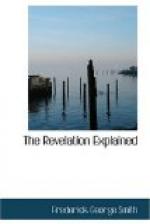It is further said that “no man might buy or sell, save he that had the mark, or the name of the beast, or the number of his name.” To “buy or sell” is to engage in the ordinary pursuits of life and have intercourse with human society. Applying this as a symbol to the analagous department of the church, we have the fact set forth that those without the special mark have no more recognized standing in the so-called churches than men that are not allowed to buy or sell have in a community. But selling, as a symbol, would specially indicate the dealing out of truth, or the preaching of the gospel. A Holy Ghost minister in the clear light of heaven’s truth, independent of all the creeds of Babylon, will not be allowed the privilege of laboring freely among sectarians, after the truth for which he stands becomes well known. And if he holds meetings in the community, the members of the sects are often warned by their leaders against “buying”—receiving—it from the Holy Ghost minister, because of his not having the mark or name of the beast. Their ministers are specially marked, for they come out of their colleges and theological seminaries with the stamp of their respective doctrines upon them and a license from the sect to enter its ministry; and those not thus marked or designated have no place among them. This may also explain the manner in which the beast causes those who will not worship the image to be killed—an analagous killing; namely, an ecclesiastical cutting-off, or excommunication, as explained in previous chapters.[9]
[Footnote 9: The early history of Protestantism shows that at that time the principle of religious intolerance brought over from Romanism manifested itself in the actual putting to death of numerous dissenters. For example see pp. 252, 291-294 of the present work. It is possible that the persecuting principle ascribed to the two-horned beast may include both the literal and the ecclesiastical cutting-off, reference being made directly to the intolerant spirit.]




